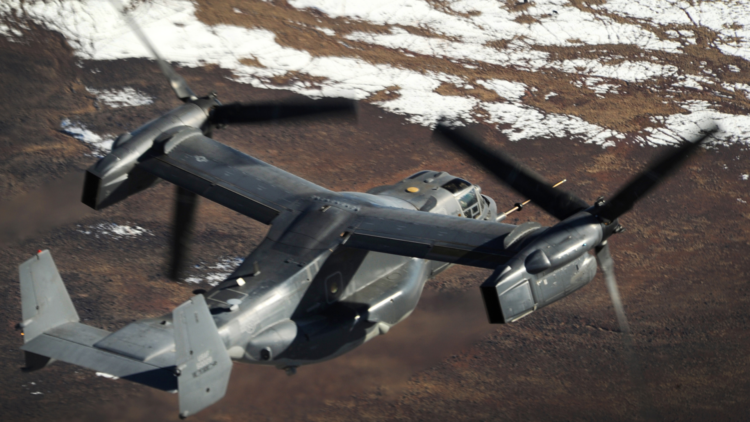In the ever-shifting sands of military aviation, where the roar of engines and the whisper of rotor blades spell the fine line between triumph and tragedy, the saga of the CV-22 Osprey crash on November 29th, 2023, unfurls its latest chapter.
The Air Force Special Operations Command (AFSOC), guardians of the sky, have peeled back another layer of the mystery shrouding that fateful day when eight of their finest were claimed by the unforgiving embrace of the earth.
A component failed, they say, a vital piece of the Osprey’s intricate ballet of technology and power, yet the reasons why this piece faltered dances just beyond their grasp, elusive, taunting.
This revelation, reported by NBC News on a Tuesday, February 20th story and now under the solemn scrutiny of AFSOC, hints at a propeller rotor gearbox gone rogue, a mechanical betrayal off the coast of Japan that snatched lives and left silence in its wake.
The promise of understanding the root cause of this failure hangs heavy, a burden of knowledge yet uncovered, with AFSOC’s pledge of silence until the puzzle is complete—a vow to the integrity of their quest for answers.
The Shadow of Material Failure
The shadow of material failure looms large, dispelling the specter of human error and pointing instead to a flaw within the flying beast itself.
Yet, the guardians of the Osprey’s tale, the AFSOC spokespeople, keep their secrets close, offering only whispers of the darkness that lurks within.
“At this time, the material failure that occurred is known but the cause of the failure has not been determined,” AFSOC wrote. “Engineering testing and analysis is ongoing to understand the cause of the material failure, a critical part of the investigation. Any disclosure of findings prior to investigations being finalized is premature and presumptive.”
CV-22 Osprey’s History of Mechanical Malaise
The Osprey, a marvel of modern aviation, is no stranger to the tempest of scrutiny, with tales of “hard clutch engagement” and the specter of mechanical failure haunting its journey.
The Air Force, in its wisdom, has wrestled with these demons before, taking actions including grounding the fleet and limiting the hours these birds of prey can soar, all in the name of safety, of preventing the reaper’s cold hand from taking more than it already has.
The Fleet at a Standstill
Now, as the investigations weave through the tangled web of technology and fate, the entire V-22 fleet stands still, a silent testament to the gravity of the crash. Lt. Gen. Tony Bauernfeind, a voice of leadership in the tumult, speaks of reviews, of inquiries into the crash, into the very soul of AFSOC’s readiness and might.
Already have an account? Sign In
Two ways to continue to read this article.
Subscribe
$1.99
every 4 weeks
- Unlimited access to all articles
- Support independent journalism
- Ad-free reading experience
Subscribe Now
Recurring Monthly. Cancel Anytime.
“As final Safety Investigation findings and recommendations are received, the priority is to inform our deliberate return to fly and ensure CV-22 aircrew and maintainers have the information they need to prevent future mishaps,” it further noted in its released press statement.
The hope of the V-22 reclaiming the sky lingers, a beacon of potential amidst the caution of preparation, training, and the relentless pursuit of safety.
Adapting in the Wake of Loss
In this pause, the military machine adapts, with Vice Adm. Daniel Cheever of the Naval Air Forces illuminating the path forward with alternative platforms, a testament to the resilience and innovation at the heart of America’s defense.
The Air Force, too, leans on its versatile fleet, ensuring that the void left by the Osprey is but a hiccup in the grand scheme of operations.
EXCLUSIVE: The investigation into the deadly crash of a U.S. military Osprey aircraft in November is looking at a possible mishap involving the aircraft’s propeller rotor gear box, U.S. officials say. https://t.co/k0BWrYwQ7t
— NBC News (@NBCNews) February 20, 2024
Osprey: Gazing Toward the Future
Yet, in this moment of reflection, the gaze turns forward to the horizon where the future of vertical lift beckons.
The dreams of DARPA’s (Defense Advanced Research Projects Agency) Speed and Runway Independent Technologies project, of the Army’s Future Long Range Assault Aircraft (FLRAA) program, whisper of advancements, of successors to the Osprey’s legacy, even as the reality of time’s slow march tempers the urgency of progress.
A Solemn Vow to the Fallen
As the curtain falls on another chapter in the investigation of the CV-22 crash, the pursuit of truth continues, a relentless march toward understanding, toward ensuring that the sacrifice of the eight souls is honored not just in memory but in action.
In the aftermath of loss, the determination to learn and improve stands as a beacon of hope, a promise to those who serve that their lives are the foundation upon which a safer, more resilient future is built.
In this narrative of technology, tragedy, and the quest for answers, the spirit of the military community shines, a testament to the resilience, dedication, and unwavering commitment of those who stand ready to defend, explore, and, when necessary, mourn.
But always to move forward, stronger, wiser, and together.

